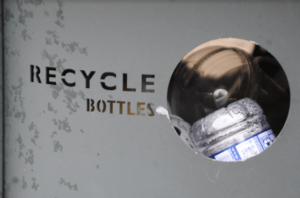 "
"
For years, Americans have been told to follow the three R’s: reduce, reuse and recycle. The three arrows of the international logo that create a bright green triangle are nearly universal in their recognition across the nation. They offer a simple avenue towards engaging with sustainability. Increasingly, however, America has a favorite ‘R’ amongst the three: recycling.
“I think recycling is a no-brainer. It makes too much sense not to do. I think it’s the responsible thing,” senior Pat Kearney said.
Until 1990, the percentage of solid waste that was recycled was lower than 15%. In 2017, it was more than twice that. In that same year, the Environmental Protection Agency reported that 67.2 million tons of material were recycled nationally, with paper and plastic making up the majority of that material.
While stats from the EPA may present an image of increasing engagement, the process of recycling is complicated, expensive and perhaps not as helpful as years of public information campaigns have led Americans to believe. Many students are left mystified by and apathetic to the process.
“It’s too complicated so therefore I don’t seek it out to understand it because I don’t care,” senior Kevin Coyle said.
In response to sentiments like this, groups on campus are now promoting a new, simpler counter-message to the third R.
“When in doubt, throw it out,” senior Whitney Lim said. “I hate saying that but it is the lesser of two evils because you don’t want to contaminate the recycling stream.”
Lim, a theology major with minors in business economics and sustainability, is a member of the small working group for waste in the Office of Sustainability and has spent much of her time as an undergraduate working within the world of going green. Lim went on to explain in detail what recycling looks like from a practical standpoint at Notre Dame.
“Let’s say someone accidentally throws out a drink that still has whipped cream in it,” Lim said. “Then this small bag of recycling is going to get tossed into a bigger bag. And then those bags are going to get tossed into a bigger dump again at the factory.”
Lim said, because of an initial contaminant which then spreads to other recycling material, bigger and bigger amounts of recycling are also contaminated and will be tossed out. For many students this is not something that crosses their mind when they’re tossing away trash.
“I just throw it away in the nearest can I can throw it in,” senior Kevin Coyle said. “I’ll just shoot it like a basketball.”
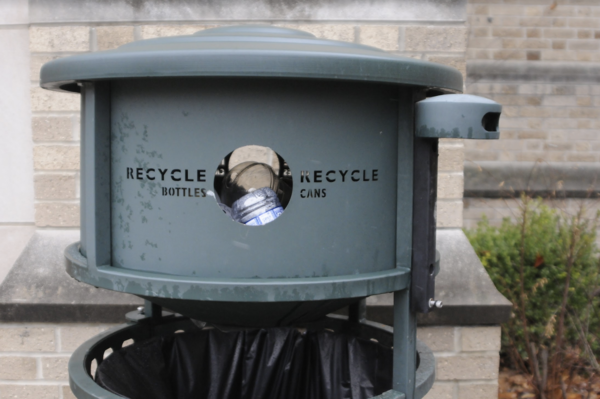
Many students also feel that there is a lack of clarity about whether or not an object can be recycled.
“I never know what I can or can’t recycle,” Kearney said. “It’s a lot of guesswork.”
By the time it reaches the factory, Lim said, “it’s too late.” Employees at recycling centers cannot dig through everything to find recyclables that were not contaminated, and cleaning individual pieces of recycling does not make financial sense. Hence, the advice, “When it doubt, throw it out.”
Lim also explained that even when products make it through to the recycling plant and are not contaminated, they still need to be sorted.
“Because we recycle cardboard, plastics, glass, metals, all that stuff, once you put it all together, you have to separate it all at the plants,” she said. Different glasses, plastics and metals need to be sorted into distinct groups so the materials can be sold back to people who want to buy a specific type of recyclable.
Once the products are sorted, the next step in the recycling process begins. Recycling plants have to sell recycled materials back to companies that want to use them for their products.
“There’s not that many companies that actually want to buy recyclables because it’s expensive and you might not get enough or it might [still] be contaminated,” Lim said. “Companies have to pay a premium and seek out that recycled material. If they’re a big company, they might not be able to source from somewhere small and that might not have what they need.”
While waste management is governmental, the buying back of recycled materials is privatized, so supply and demand is not always consistent.
Prior to 2017, the United States shipped 70% of its plastic recyclables to China where low labor costs and high demand were paired with favorable shipping rates, as cargo vessels emptied of Chinese consumer goods could be filled with recyclables and sent back to China.
However, beginning in January 2018, according to the Chinese National Sword policy, China would no longer accept plastic and other materials in an effort to stop the overwhelming barrage of unusable, soiled and contaminated materials.
“They were just like stop sending us your trash,” Lim said.
Countries that once relied on China are now facing a recycling crisis as they are unable to handle millions of tons of recycling in an industry that is increasingly unprofitable. Plastics and other recyclables are now being incinerated or dumped into landfills.
So while a throwaway culture favors the ease of tossing dirty plastic and paper products into an easily accessible bin, “unfortunately, it’s not that easy,” Lim said.
Recycling, however, is just the tip of the iceberg. Younger generations are becoming increasingly frustrated by the significant damage done to the environment and the lack of institutionalized sustainable practices.
Greta Thunberg, at just 17 years old and in a short period of time, has become an icon of the global movement towards climate action. In August of 2018, she led a school strike for the climate and has since made headlines while speaking at the U.N., challenging prominent international leaders and, as was reported by TIME, leading the largest global climate strike in human history. In December 2019, she was named TIME’s Person of the Year.
Thunberg’s efforts, and the efforts of many other young and impassioned climate activists, who say they have shined a light on concerns deeply felt by younger generations who are left to steward a planet ravaged by human-engineered environmental destruction. In a sign of the times, the 2019 Oxford Word of the Year was ‘climate emergency.’
“Twenty-nineteen was the second hottest year on record, with the past decade the hottest in human history. Greenhouse gas concentrations are at the highest levels in 3 million years — when the Earth’s temperature was as much as three degrees hotter and sea levels some 15 metres higher. Ocean heat is at a record level, with temperatures rising at the equivalent of five Hiroshima bombs a second. We count the cost in human lives and livelihoods as droughts, wildfires, floods and extreme storms take their deadly toll. We have no time to lose if we are to avert climate catastrophe,” said U.N. Secretary-General António Guterres, in his opening remarks at a March 10, 2020 press conference.
As global voices continue to reiterate how dire the climate crisis is, finding ways to be a part of the solution for both individuals and institutions is especially pressing. At Notre Dame, this responsibility falls on the shoulders of everyone on campus.
“Everyone has to care about climate change,” Lim said.
Attempting to better understand how this issue resonates at home, Scholastic took an in-depth look at how Notre Dame is responding to this and similar calls to action.
Trash or Recycling?
“Sustainability” is a term with a wide scope. Energy efficiency, waste management and water are all subsections integrally related to sustainability as a whole. For the average Joe, though, there is perhaps no more obvious and present subsection of sustainability than recycling.
Every time you go to throw away a food or drink container, paper or other material, you are met with a choice: trash or recycling?
At Notre Dame, nearly every trash bin has a recycling bin next to it. Some classrooms and offices have even more recycling bins than they do trash cans. When these bins are not carefully paired together, the risk for contamination increases.
“Every person plays their own individual role when it comes to sustainability,” said senior Abby Eifert. “You could have 90 people separating their trash and recycling but as soon as one person dumps a soda can on top of that, it’s no longer going to be feasibly recycled material.”
With Notre Dame’s single-stream recycling system, one contaminated material in a recycling bin can have a larger negative impact. While single-stream recycling is designed so that the items thrown in a single bin can be sorted that does not mean that those products can be magically cleaned, according to Allison Mihalich from the Office of Sustainability.
“[One contaminated material] ends up contaminating more than just the bin they’re throwing it in,” Mihalich said. “All of those bins are brought to an exterior container.” As a result, she said, one contaminated material can contaminate a wide range of materials, essentially making them all trash.
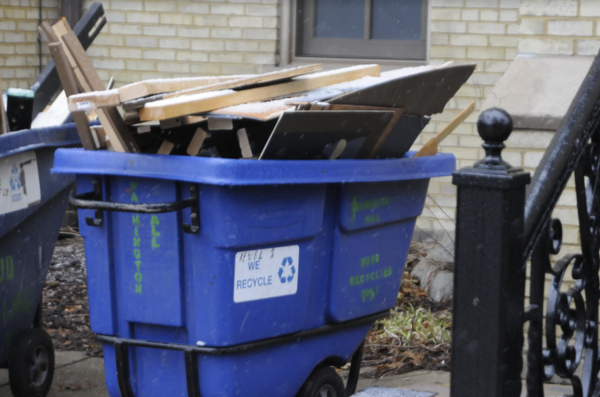
Notre Dame has sought to increase awareness of what can and cannot be recycled, with varying degrees of success, students said.
“I feel like they do a good job engaging people on social media and how you can recycle better on campus, because I learn things I didn’t know before … there’s good signage and stuff, too … it’s all very clear, and I feel like it’s not on other campuses,” sophomore Grace Kulin said.
The Office of Sustainability has encouraged students to educate each other about proper recycling methods to boost the collective campus-wide effort to decrease contamination.
Carol Mullaney, the senior director at the Office of Sustainability, urges students to remember “even recycling is a form of waste.”
“It’s really important to be mindful of ‘how can I do this right,’” Mullaney said. “And if you see someone doing the wrong thing, being OK with saying, ‘Did you know that only two of the three parts of your Starbucks cup are recyclable?’”
Students like Eifert have taken this call to heart, trying to inform and inspire friends and peers.
“Recycling itself is way more of a complicated topic than other sustainability fields,” Eifert said. “The best way that I’m able to educate people is through conversation, and also leading by action.”
Eifert’s actions range from personal — using reusable straws and utensils as well as encouraging her friends to take “one-song” showers — to more official. She works on sustainability in study abroad programs and takes part in the gameday recycling program during which a number of student volunteers peruse tailgates to divert recyclable materials and educate the broader Notre Dame community on the issue.
While students like Eifert and administrative services like the Office of Sustainability take initiative at Notre Dame, there is still plenty of work to be done. In dorm communities in particular, trash and recycling are often lumped into one. Bins in individual rooms as well as at the end of hallways can become trash bins, no matter how they’re marked.
“I think the recycling bins here — half the time, there’s just trash in it, so none of it actually gets recycled. Because you can’t recycle things in a recycling bin if there’s even a bit of trash in it,” said first-year student Vito Lin.
“I’m just wondering why the recycling bin is smaller than the trash can, and there’s absolutely no reason for it to be smaller,” junior Matthew Trinh said. “If anything, it makes it harder to recycle because it fills up faster and you’re wasting a trash bag if you change it out every single time instead of just dumping it into the recycling bin.”
The Office of Sustainability is hoping to increase awareness in the dorms with the sustainability commissioners program, through which students educate their peers in the residence halls about what can and can’t be recycled, ideally increasing participation.
Additionally, the university is experimenting with segmented stream recycling with the possibility of shifting from solely single-stream recycling in the future.
“We would rather collect a smaller number of commodities that are clean and easily recyclable than have single-stream that is easily contaminated,” Mullaney said.
Food Waste
One main source of recycling contamination is from food and drink. Increasingly, food sustainability has become an important aspect of waste management.
In 2019, the university implemented Grind2Energy, a system that recycles food waste by converting it into energy that is clean and renewable. The project is part of the University Comprehensive Sustainability Strategy introduced in 2016.
“Different people do projects for classes and one common class project that apparently the Office of Sustainability kept getting asked about is composting on campus,” said senior Matthew Magiera, a chemical engineering major.
But “there are real difficulties that come with scaling up composting,” Magiera explained.
In a video released by the Office of Sustainability, Mihalich, the senior program director, explains that concerns about exposure, rodents, leakage, odor, space constraints and labor intensity underscored the impracticability of composting on campus.
“If we can’t do composting, what can we do?” Magiera said.
This is where Grind2Energy comes in. In his time as an intern at the Office of Sustainability, Magiera worked with Mihalich to implement the system, which he said other schools had begun using as well.
The system essentially transforms organic waste from the dining halls into slurry. This mixture then undergoes anaerobic digestion. This breakdown of organic matter produces methane-rich biogas and byproducts like fertilizer.
Importantly, the process diverts food waste from landfills, thus reducing greenhouse gas emissions, said Magiera. Other initiatives also help decrease the amount of food that might become landfill waste.
Smaller trays, tray inconvenience and even "trayless" initiatives in dining halls can reduce food waste by as much as 14 percent, according to Campus Dining.
Organizations like Food Rescue U.S. and Cultivate Culinary collect uneaten food from campus dining locations and university events to distribute meals to food-insecure people and families in South Bend.
But with Grind2Energy in place, plans for a more sustainable food system on campus are even less wasteful. By Mihalich’s estimates, the anaerobic digester will reduce campus waste by 10 percent, or 700,000 pounds each year.
Education, Outreach, and Public Relations
In addition to efforts by the Office of Sustainability, the university has numerous professors and classes that increase sustainability awareness and practices through education. The sustainability minor, which saw its first class graduate in 2013, is open to students of all majors and colleges, requiring just 15 credits. More broadly, the Notre Dame sustainability studies website lists 68 members of the faculty whose study and courses relate to the topic, with disciplines ranging from conservation biology, to theology of nature, to design.
For example, Professor Jessica McManus Warnell, associate professor in the Mendoza College of Business, teaches the required business ethics course, which has a dedicated section on sustainability, as well as an elective course in sustainable business.
“My thoughts on sustainability generally: I think there’s a business case and a moral case,” said McManus Warnell.
Now entering her 20th year at Notre Dame, McManus Warnell has seen the importance of sustainability grow within Mendoza and the national and international business community as well.
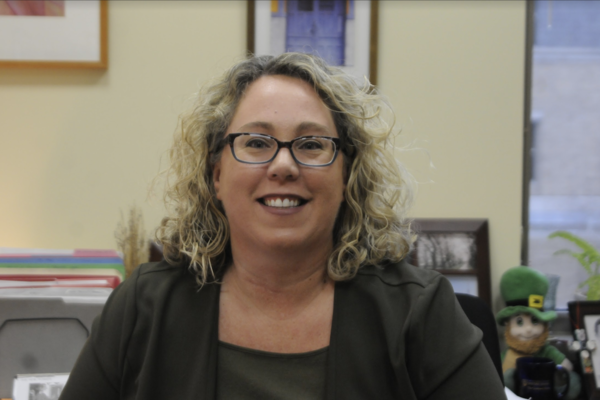
“We’re in a space where a transition is happening,” McManus Warnell said. “The old school business strategy viewed pursuing sustainability as a constraint, but I think things are changing. Companies are realizing there are opportunities that can be realized through this.”
McManus Warnell views Mendoza as having a large role to play and being a part of the solution. As she is proposing classes on global business and sustainability being a part of the new core curriculum, Mendoza’s attention to and education of the issue only seems to be growing.
Outside of Mendoza, professors such as Ann Marie Conrado are working to design and introduce more sustainable products into the market.
“Up to 80% of the environmental impact of anything that we interact with has already been determined long ago in the design phase,” Conrado said.
For example, Conrado cited a more sustainable showerhead which reduces water usage by turning water to steam during soaping, and a printer which defaults to only printing the first page or two of a website as opposed to the whole page, which often includes unnecessary advertisements and blank space.
By teaching introduction to design matters, Conrado has worked with students minoring in collaborative innovation, through which students from a wide range of backgrounds and perspectives come together to brainstorm “changing the way we’ve always thought about sustainability.”
The college of engineering also has a large role to play in teaching students about sustainability, though perhaps indirectly through energy efficiency.
Professor David Go, for example, has researched how to repurpose the heat generated by computers for other practices as opposed to letting it go to waste. He has worked on additive manufacturing — 3D printing — to develop “more predictive” software that reduces waste as well.
Go said numerous colleagues, including Peter Burns, Subhash Shinde and Prashant Kmat, whose studies range from solar energy to thermoelectrics, as playing a large role in both educating and developing the next wave of sustainable engineers.
What McManus Warnell, Conrado, and Go all agreed is that the coming years have a large role to play in the future of sustainability.
“We’re at a tipping point,” Conrado said. “It’s incumbent for us to try to approach sustainability differently.”
Energy and Emissions
Perhaps one of the greatest moves towards approaching sustainability on campus occurred when in 2019, Notre Dame announced that it had ceased to burn coal, a year ahead of schedule. A part of a long term plan pertaining to energy and emissions, the decision brought Notre Dame closer to its goal of reducing carbon emissions and fulfilling the call to action in Pope Francis’ 2015 encyclical “Laudato si’” which urged the Catholic community to prioritize sustainability.
“When I came to Notre Dame 23 years ago,” Peter Burns, the director for the Center for Sustainable Energy, said. “There was a big old coal pile out by the physical plant. Train cars would come to campus to dump coal. And over time that pile shrunk, I know this, but it was still there.”
According to Burns, switching from coal to natural gas made financial sense. Natural gas is cheaper and cleaner. There are no moving train cars. It comes in a pipe so it is easier to transport.
“I believe it was in response to the pope’s encyclical, “Laudato si’,” that the president [of Notre Dame] made the decision that we would move away from coal in five years from that moment in time,” said Burns.
While at that time, the university was no longer buying coal and was predominantly using natural gas, it continued to use coal as a backup fuel.
“Up until quite recently we were using the remaining coal as our backup fuel, but as of a few months ago we no longer have any coal and we have no intention of burning coal again,” Burns said. Now the university uses furnace oil as its back up fuel and has expanded its use of renewable energy sources for its primary energy needs.
These and many other actions are a part of why the university has managed to reduce carbon emissions by 50% per gross square foot, according to the Office of Sustainability’s website. Their hope is to reduce emissions by 83% by 2050 and eventually to become carbon neutral.
Many of the plans pertaining to climate action on campus are guided by the Office of Sustainability. The office’s main functions is to partner with and facilitate the work of other campus organizations in addition to promoting sustainability directly. The Office has partnered with Moreau First Year Experience, for instance, to introduce sustainability-related topics into the Moreau curriculum. As the Office of Sustainability puts it, this will immerse first-year students in a “culture of sustainability” from the very start. “From our perspective, that is an achievement.”
This philosophy of partnership applies especially to energy, which is managed by multiple campus departments.
“I don’t think our office, very honestly, can say the achievement of hitting the 50% carbon emissions reduction goal a year ahead of schedule … it's the utilities department that did the hard work,” Mullaney said. “But we helped support them, partner them, and helped tell their story. I think they look at us as a partner. But we’re pretty excited about that! We’re pretty excited that we’re no longer burning coal.”
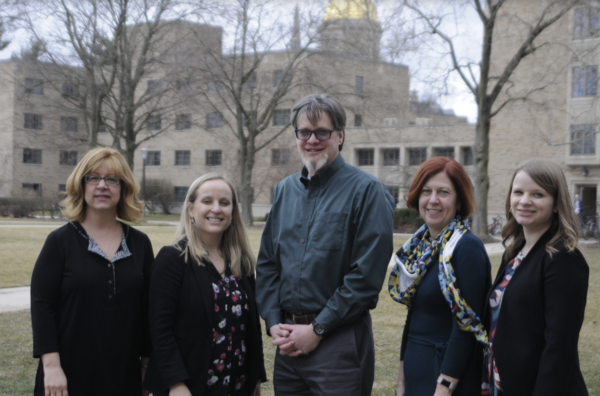
Speaking to Notre Dame’s energy use, the Office of Sustainability also discussed the university’s efforts to expand its reliance on geothermal energy. Notre Dame outsources around half its energy, the Office told Scholastic, while producing the rest on campus “at the power plant or off-site through various partnerships.” The move away from coal and natural gas has driven the university to seek more renewable forms of energy.
Notre Dame is “uniquely situated” to rely on geothermal energy — the “natural warming and cooling capabilities” generated by the planet. Other forms of renewable energy that the university has sought to exploit include solar and hydroelectric. A new hydroelectric plant in Seitz Park, for instance, will supply 7% of Notre Dame’s energy in the future.
Another energy and waste-related campaign of the Office of Sustainability includes its efforts to replace toilet paper tubes containing cardboard rolls with coreless rolls, which cuts down on waste. As Jeff Edgerly, the assistant director for building services, said, “No one wants to talk about restrooms, but if you think about it … we’ve eliminated that core, and still provided that service that’s required in the restroom. It’s a huge deal for us.” This initiative is obviating the need to recycle cardboard toilet paper rolls — “a huge labor saver” as well as an environmental boost, said Edgerly.
Prioritizing Sustainability: What Needs to Be Done
On campus, discouragement represents a big obstacle in the path to sustainability, students said.
“People are really excited about big-picture ideas, but not as hopeful on [a] day-to-day [basis],” said Cassondra Kronenberg, one of McGlinn Hall’s sustainability commissioners and an intern at the Office of Sustainability.
In addition to student apathy, the Office of Sustainability only employs five full-time members. While the office continues to push for the goals it has set for the university, “Just having more paid people to work on sustainability would be the number one thing for the university to do,” Whitney Lim said.
However, “the interest is there, and we'll get there, but it just takes a couple of years to actually build it up,” said Reagan Mulqueen, a student intern at the Office of Sustainability, regarding student and dorm involvement with green initiatives.
Uncertainty about what can be done also hinders progress: "Students are very concerned about [sustainability] at the macro level, but very confused at the micro level," Professor Ann Marie Conrado said.
Despite this discouragement, sustainable development is widely understood to “meet the needs and aspirations of the present without compromising the ability to meet those of the future,” according to a definition introduced in Our Common Future, a 1987 Report of the World Commission on Environment and Development.
At a university-sponsored conference in 2016, the Language and Culture Director of the Pokagon Band of the Potawatomi (Pokégnek Bodéwadmik), Marcus Winchester, talked about indigenous philosophies of sustainability.
Similarly to the concept of sustainable development, one such indigenous philosophy — the Seventh Generation Principle — revolves around the idea of “always thinking seven generations ahead,” he said.
The Pokagon Band of Potawatomi Indians once resided on the land upon which the university is now built.
“The things that we enjoy today, the things that we are able to take advantage of today, [are] a direct result of the decisions that somebody made seven generations ago,” Winchester said at the conference. “They were thinking of us seven generations ago; they wanted us to have a good home, they wanted us to have a good way of life … and we need to pay that forward.”
Tips for Sustainable Living
Engaging with sustainability can be overwhelming. Scholastic compiled a list of things you can do to live more sustainably today.
- Clean your recyclables!
- Use reusable bags at the grocery story.
- Use a reusable water bottle or a tumbler.
- Buy local.
- Eat vegetarian for one meal a day or one day a week.
- Use plant-based soaps and lotions.
- Do laundry less or hang dry your clothes.
- Turn off the lights.
- Go thrifting.
- Wait to check out on Amazon until you have a bigger cart.
- Use public transportation.